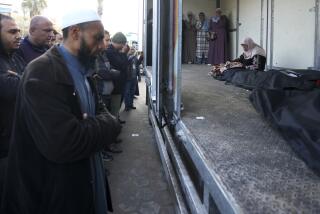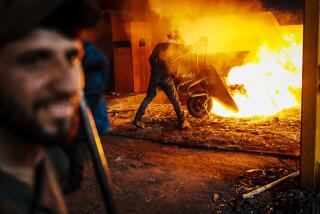U.S. Plans No Letup in Its Afghan Air Assault
- Share via
WASHINGTON — Pentagon officials signaled Monday that they plan no immediate letup in the intense bombing of Afghanistan, another indication that U.S. forces want to destroy as much of the Taliban regime and the Al Qaeda terrorist network as possible before the advent of the Muslim holiday of Ramadan in mid-November and winter weather.
After slowing somewhat at the end of the first week of bombing, U.S. forces have been striking targets with 80 to 100 warplanes a day for most of the past week. On Monday, they struck again at a range of targets across the country, including Taliban forces dug in north of the capital, Kabul, and those battling near the strategic northern city of Mazar-i-Sharif.
Senior U.S. officials insist that they will not let cold weather or the Muslim holiday protect the adversary’s forces. However, they acknowledge that winter will slow some operations and that they would prefer not to offend Islamic sensibilities.
Pakistan’s president, Gen. Pervez Musharraf, a key U.S. ally, provided a reminder Monday of the sensitivity of the timing issue, warning that the beginning of Ramadan will intensify Muslims’ concerns about the airstrikes.
“One would hope and wish that this campaign comes to an end before the month of Ramadan,” Musharraf said on CNN’s “Larry King Live.” “And one would hope for restraint during the month of Ramadan, because this would certainly have some negative effects in the Muslim world.”
Secretary of State Colin L. Powell acknowledged Sunday that it would be preferable “to see this matter resolved” before winter makes military operations more difficult in Afghanistan. At the same time, Air Force Gen. Richard B. Myers, chairman of the Joint Chiefs of Staff, cautioned that the campaign could last into the spring and well beyond.
On Monday, Myers also said that the U.S. commando raid conducted early Saturday near the Afghan city of Kandahar--the first U.S. ground assault in the country--did not necessarily presage a slowdown in bombing.
Such a slowdown in air attacks in the aftermath of ground assaults was the pattern of the Persian Gulf War and other recent conflicts. But Myers said: “This is not a linear war; this is not a sequential war. To think of this in phases, as we have with other conflicts--we’ve got to clear our minds of that.”
In other developments, Taliban officials charged that allied warplanes had killed about 100 people in a bomb strike on a hospital in the western Afghan city of Herat.
Myers said the Pentagon could neither confirm nor deny the charge and was investigating. “The last thing we want to do is cause civilian casualties, so we’re still looking,” he said.
If true, the strike during raids late Sunday or early Monday would be the most dramatic bombing error of the campaign and would strengthen the Taliban’s efforts to turn public opinion in other Islamic countries against the United States.
In fighting Monday, anti-Taliban forces appeared to suffer a new setback in a battle near Mazar-i-Sharif, although Myers said a new offensive was about to begin.
Anti-Taliban forces were pushed back more than four miles from the city as the fighters waited for ammunition and medical supplies, the top Northern Alliance official acknowledged in Tashkent, the capital of neighboring Uzbekistan.
U.S. warplanes have been bombing Taliban positions well south of Mazar-i-Sharif to help the advance of another group of Northern Alliance troops stuck 35 miles from the city, said Mohammed Hashad Saad, representative in Tashkent for the Northern Alliance.
The Northern Alliance said last week that it was on the verge of taking Mazar-i-Sharif and had reached the outskirts of the city. But the Taliban brought in reinforcements and forced the opposition fighters to withdraw into hills to the south.
Since then, the better-armed Taliban troops have caused the Northern Alliance to pull back even farther into the hills.
Nevertheless, Myers suggested that this setback might not be significant. He said that the efforts of the U.S. air assault and the opposition’s ground offensive “are starting to come to a head, and we may see progress in that area in the not-too-distant future.”
Meanwhile, the Pentagon released more information about the U.S. commando raid in Afghanistan, identifying the airfield that Army Rangers parachuted onto about 80 miles southwest of Kandahar.
The field is called Bibi Tera, and was described by Myers as a relatively primitive airstrip. The other target of the raids was a compound in Kandahar that included a residence of Taliban leader Mullah Mohammed Omar, who was not present when the U.S. troops arrived.
On Monday, the British government signaled its willingness to send ground troops into Afghanistan alongside U.S. forces, while asserting that the international community must be prepared to act “very quickly” if the Taliban regime suddenly collapses.
British Defense Secretary Geoff Hoon said no decision has yet been made on British troop deployments but that “we are exploring all of the possibilities,” including ground troops.
Since the air war began Oct. 7, Britain has fired cruise missiles on two occasions and has been engaged in air reconnaissance and refueling missions. It is believed that members of Britain’s Special Air Services are carrying out intelligence work inside Afghanistan, but the government does not discuss such operations.
News reports last week that U.S. Special Forces teams were operating in Afghanistan brought an angry denunciation Monday from Defense Secretary Donald H. Rumsfeld.
Rumsfeld called the leaks, which appeared in stories Friday, “a violation of federal criminal law . . . and something that was totally in disregard for the lives of the people involved in the operation.”
On the refugee front, witnesses said the situation was calm but tense Monday after reports of chaotic scenes involving thousands of refugees crowding at Afghanistan’s main border crossing into Pakistan at Chaman, north of Quetta.
A team from the United Nations Children’s Fund spent much of the day distributing relief supplies in the area. Team members said they had brought enough blankets, food and other emergency provisions for 10,000 people, but found only about 2,500 stranded in the open on the Afghan side of the border.
*
Richter reported from Washington and Paddock from Tashkent. Times staff writers Tyler Marshall in Quetta and Marjorie Miller in London contributed to this report.
More to Read
Sign up for Essential California
The most important California stories and recommendations in your inbox every morning.
You may occasionally receive promotional content from the Los Angeles Times.














